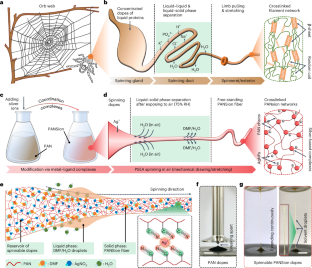2023-07-10 シンガポール国立大学(NUS)
◆この方法で製造された繊維は、ゲーム用のストレインセンシンググローブや、呼吸状態を監視するスマートフェイスマスクなど、さまざまなスマートテクノロジーアプリケーションに利用できます。また、この方法は持続可能性にも配慮しており、繊維は再利用可能で、エネルギー消費と化学物質の使用量が少ないです。今後もさらなる持続可能性の向上に取り組む予定です。
<関連情報>
- https://news.nus.edu.sg/nus-researchers-create-method-to-produce-soft-recyclable-fibres/
- https://www.nature.com/articles/s41928-023-00960-w
自然相分離によるソフト機能性繊維のバイオミメティック紡糸 Biomimetic spinning of soft functional fibres via spontaneous phase separation
Songlin Zhang,Yihao Zhou,Alberto Libanori,Yibing Deng,Mingyang Liu,Mengjuan Zhou,Hao Qu,Xun Zhao,Peng Zheng,You-Liang Zhu,Jun Chen & Swee Ching Tan
Nature Electronics Published:27 April 2023
DOI:https://doi.org/10.1038/s41928-023-00960-w

Abstract
Soft fibres can be used to make smart textiles for use in energy, sensing and therapeutic applications. However, the fabrication of functional fibres is difficult compared with the fabrication of two-dimensional films and three-dimensional monoliths, and current methods typically require high temperatures, high volumes of solvents or complex systems. Here we report a spinning approach to fabricate functional fibres, which is based on spontaneous phase separation and is inspired by the silk-spinning processes of spiders. The silk-spinning process is mimicked by creating a spinning solution of polyacrylonitrile and silver ions, which forms an elastic supramolecular network with silver coordination complexes and in situ reduced silver nanoparticles. This approach, which operates at ambient pressure and temperature, can be used to make soft functional fibres that are mechanically stretchable (more than 500% strain), strong (more than 6 MPa) and electrically conductive (around 1.82 S m−1). To illustrate the capabilities of the technique, we use the fibres to create a sensing glove and a smart face mask.



